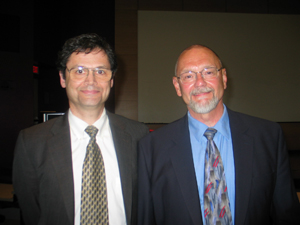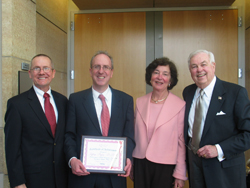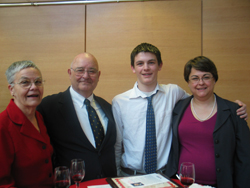 |
From left: UNMC Scientist Laureate Stephen Rennard, M.D., with Tom Rosenquist, Ph.D., UNMC’s vice chancellor for research, at the Distinguished Scientist Award Ceremony on Monday. |
And, for more than an hour, they stepped away from their labs to celebrate their research accomplishments.
UNMC’s first Distinguished Scientist Award Ceremony honored 24 researchers who have been among the most productive scientists in the country over the past five years. They represented the colleges of dentistry, nursing, medicine and pharmacy, as well as the Eppley Institute.
The awards, announced last fall, followed an extensive, exhaustive and objective process, said Thomas Rosenquist, Ph.D., vice chancellor for research at UNMC. “Your value to UNMC and biomedical research is infinitely larger than today’s recognition,” he said. “But, we’re proud that the best and brightest at UNMC, the U.S. and the world at-large, includes you.”
Of the distinguished group, Stephen Rennard, M.D., was selected the 2006 Scientist Laureate for his clinical investigation of chronic obstructive pulmonary disease and smoking cessation and a program of basic research in the mechanisms of lung tissue repair and remodeling.
On behalf of all the recipients, Dr. Rennard thanked the many colleagues, lab personnel and collaborative teams who make research possible. “All of us recognize that none of us do research in isolation,” he said.
 |
From right:Gene and Rosemary Dixon traveled to Monday’s ceremony from San Mateo, Calif., to salute Jeffrey Payne, D.D.S., the F. Gene and Rosemary Dixon Endowed Chair in Dentistry at the UNMC College of Dentistry. John Reinhardt, D.D.S., dean of the College of Dentistry, is on the left. |
Administrators and department chairs were excluded from the competition and recipients were selected based on their history of leading an outstanding research program, publishing research results in journals of the highest quality, and showing the ability to attract and retain extramural funding.
Each Distinguished Scientist received a framed certificate and merit-based salary supplement of $10,000. As scientist laureate, Dr. Rennard received a $20,000 supplement.
“As a researcher, I don’t think there’s anything as gratifying as finding something that no one else in the world knows but you,” UNMC Chancellor Harold M. Maurer, M.D., told the group. “Congratulations to all of you for receiving this unique award.”
Since his first day as chancellor, the internationally-recognized leader in pediatric cancer research has known his legacy would be to build the research enterprise. “On my tombstone, it will say ‘he built research at UNMC’ … If you have a strong research program you have outstanding education and patient care,” he said.
UNMC’s research funding from external sources is now nearly $80 million annually, but Dr. Maurer’s vision — and goal — is to reach $200 million by the end of 2009.
 |
Pascale Lane, M.D., far right, with her parents, Pat and William Hammond, and her son, Tim. |
Although the funding cycle is down, Dr. Rennard doesn’t see a crisis within biomedical research. “Compassion and curiosity are the roots of biomedical research, and as long as those are present, we’ll be here,” he said.
Controversy over research also has its place, he said. “Good research is research that advances knowledge. Great research challenges what we think we know,” Dr. Rennard said. “Great research, by its very nature, will be controversial. If not, it’s not challenging what we know. If there are no controversies, you can rest assure our research is really not first rate.”